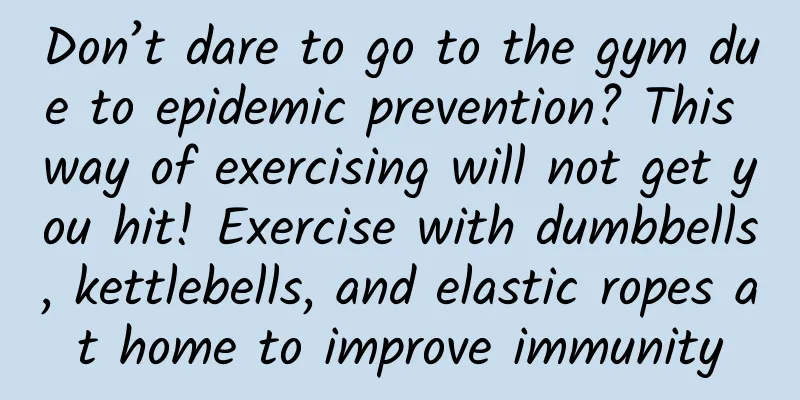Don’t dare to go to the gym due to epidemic prevention? This way of exercising will not get you hit! Exercise with dumbbells, kettlebells, and elastic ropes at home to improve immunity

|
Recently, due to the Wuhan pneumonia (COVID-19), many people are afraid to go to the gym to exercise, worried about getting infected? For people who only exercise occasionally, their lives will not change much if they don't go to the sports venues to exercise. However, the risks of obesity and cardiovascular disease caused by long periods of sitting and lack of exercise are no safer than viruses. Rehabilitation doctors say that if you are worried that public places are not safe enough, you can use dumbbells, kettlebells, elastic ropes, etc. at home instead of using equipment in the gym to train. This not only strengthens your body and helps improve your immunity, but also reduces the risk of infection by avoiding crowded environments. If you exercise in a well-ventilated, less crowded gym, the risk of contracting the virus is low as long as you have good hygiene habits. According to current information, the virus can be transmitted through droplets, but there is no evidence that it can be transmitted through the air. This means that if you are carrying the virus, once you spit into someone else's nose or mouth while talking, they may be infected if they ingest the saliva. Or if the saliva is sprayed onto something, you may touch it and then ingest the virus, which makes you more likely to be infected. But you won't be infected just because you are close to each other and breathe the same air. Therefore, if a few people go hiking or road running together, or work out in a well-ventilated but not crowded gym, as long as they have good hygiene habits, there is little risk. How to exercise during the epidemic prevention period? Rehabilitation physicians recommend: 150 minutes of moderate-intensity exercise per week + 2 days of resistance training per week So, how should we exercise during the epidemic prevention period? Lin Xingqing, attending physician of the Rehabilitation Department of Linkou Chang Gung Memorial Hospital, recommends that healthy people should try to maintain 150 minutes of moderate-intensity exercise per week and 2 days of resistance training per week. Because, according to the recommendations of the American College of Sports Medicine, it is best for the average person to maintain 150 minutes of moderate-intensity exercise per week, which means exercise that makes you sweat and breathe a little, plus resistance training at least 2 days a week. Good resistance training involves using weights that stimulate the muscles, preferably large muscle groups, so just shaking your hands or simply stretching is definitely not enough. In fact, there are many options for aerobic exercise because they can be performed in different spaces. For example, a few people can go running, hiking, or cycling outdoors together. Basically, there is no need to worry about infection, and cardiopulmonary function can be maintained. Some community buildings have public facilities such as treadmills. As long as the equipment is well ventilated when in use, the handrails are cleaned and disinfected, and you wash your hands frequently before and after use and do not touch your face with your hands, you do not have to worry too much about being infected with the virus. There are many options for aerobic exercise because they can be performed in places other than confined spaces. For example, a few people can go running, hiking, or cycling outdoors together. Basically, there is no need to worry about infection, and cardiopulmonary function can be maintained. Is it not possible to train further during home quarantine and in an environment with limited equipment? Dr. Lin Xingqing suggested that if we only have dumbbells, kettlebells, or even elastic bands, there is still a chance to promote muscle growth. To increase muscle size and strength, the best fitness method is to use: low repetitions and heavy weights However, professional gyms are not so easy to replace. The equipment-based training that fitness enthusiasts usually use naturally has the advantages of being efficient and safe. Anyone who works out knows that the best way to increase muscle size and strength, rather than simply improve endurance, is to use low repetitions and heavy weights. For example, beginners may use 60-70% 1RM (1RM represents the maximum strength limit) and 8-12 repetitions as a set of training, while more advanced ones may use 80-100% 1RM and 1-6 repetitions as a set of training. Some studies have shown that it is possible to take two weeks off from your training schedule and still see gains in muscle size and strength. However, in unavoidable circumstances, perhaps during home isolation and with limited equipment, is it not possible to train further? Dr. Lin Xingqing suggested that if we only have dumbbells, kettlebells, or even elastic bands, there is still a chance to promote muscle growth. According to a randomized controlled study published in the Asian Journal of Sports, trained subjects who used 30-50% of their 1 RM and performed 25-35 repetitions per set may have a better effect on muscle hypertrophy than those who used 70-80% of their 1 RM and performed 8-12 repetitions per set. Although we cannot overturn the most efficient method recognized in the past just because of a study with a small sample size, it may be a training method that can be used as a reference when there is no way to go to the gym. [Recommended dumbbell squats and deadlifts] The following is a demonstration by Coach Cai Qiru, founder of MedEx, on how to do squats and deadlifts with dumbbells. You may want to follow along and practice at home: Squat Squat front 1 Squat front view 1 (demonstration/Coach Cai Qiru, founder of MedEx) Squat front 2 Squat front view 2 (demonstration/Coach Cai Qiru, founder of MedEx) Squat side 1 Squat side 1 (demonstration/Coach Cai Qiru, founder of MedEx) Squat side 2 Squat side 2 (demonstration/Coach Cai Qiru, founder of MedEx) Action points:
Main muscle groups trained: It is a whole-body movement, mainly focusing on the lower limb muscles (quadriceps, biceps, gluteal muscles, etc.) Deadlift Deadlift front 1 Deadlift front 1 (demonstration/Coach Cai Qiru, founder of MedEx) Deadlift front 2 Deadlift front 2 (demonstration/Coach Cai Qiru, founder of MedEx) Deadlift lateral 1 Deadlift lateral 1 (demonstration/Coach Cai Qiru, founder of MedEx) Deadlift lateral 2 Deadlift lateral 2 (demonstration/Coach Cai Qiru, founder of MedEx) Action points:
Main muscle groups trained: It is a whole-body movement, mainly focusing on the lower limb muscles (quadriceps, biceps, gluteal muscles, etc.) Note: It is recommended to seek guidance from a professional fitness person/coach before proceeding. |
Recommend
Lose weight during the menstrual cycle, slim down in 28 days! Traditional Chinese Medicine: 4 stages of "eating like this" to build a physique that is easy to lose weight
Girls can also successfully lose weight by using ...
Tips on preventing cervical precancerous lesions
What are the methods to prevent women from having...
Learn more about the symptoms of right ovarian cyst
What are the symptoms of right ovarian cyst? Wome...
Let’s learn about the symptoms of irregular menstruation with the experts
There are different manifestations of irregular m...
How much does it cost to check gynecological diseases? What should be paid attention to before checking gynecological diseases?
Issues regarding gynecological examinations appea...
Does pelvic effusion affect pregnancy?
Does pelvic effusion affect pregnancy? This quest...
What is the reason for continuous bleeding after abortion? What should I do?
What is the reason for continuous bleeding after ...
When can I wash my hair after an abortion? How many days after an abortion can I wash my hair and take a bath?
When can I wash my hair after an abortion? Aborti...
Causes and hazards of cervical erosion
Cervical erosion is a manifestation of eversion o...
Causes of cervical hypertrophy in life
Among the many diseases of the cervix, cervical h...
What is the difference between implantation bleeding and menstruation?
Of course, there are still big differences betwee...
There are signs of myocardial infarction! Be careful of two major warning signs after exercise and meals
The temperature dropped sharply and the founder o...
What are the symptoms and signs of cervicitis in women?
Women of childbearing age are most likely to expe...
How much does surgery for endometrial tuberculosis cost?
When it comes to the treatment of endometrial tub...
What measures can effectively provide care for ectopic pregnancy?
Among the many gynecological diseases, ectopic pr...









